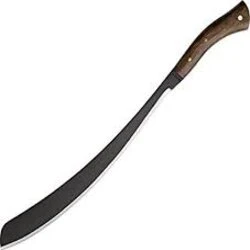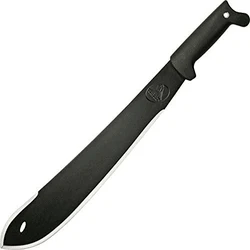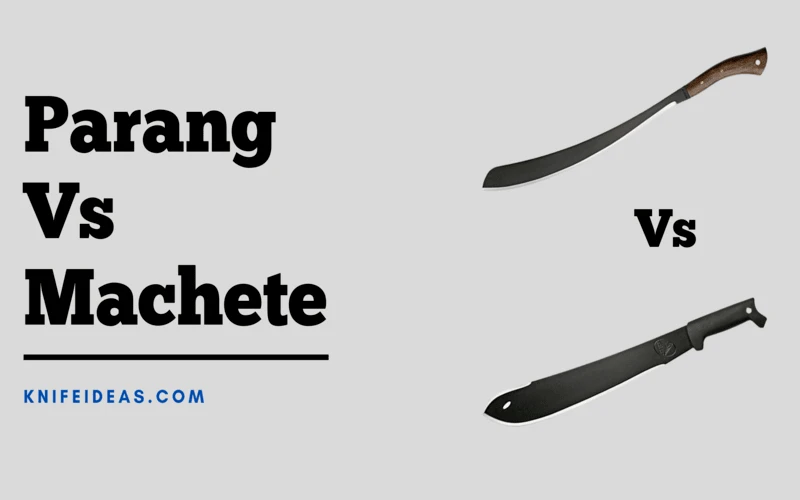Parang vs Machete – Know the Difference
by Hari Won
Knife lovers usually confuse a parang knife with a machete. We see stylish machetes daily in our lives. They are helpful for us in many ways.
A parang Machete is a particular type of knife that originates from Malaysia. This parang vs machete comparison is going to help you distinguish both of them.
Regardless of their resembling appearance, both the parang and machete tools serve different purposes. From their invention to cutting capabilities, you will find noticeable differences between the two.
We find it relevant to discuss that both of these knives are highly beneficial in their own ways. From clearing woody vegetation to thick brushes and agricultural uses to campsite hikes, they are handy companions. This comparison is meant to help you select a tool that appropriately matches your requirements.
In this detailed debate, we have defined both of these tools with their pros and cons. The detailed description of the differences between the two items in this article would further aid you in selecting the best tool for you.
A careful analysis of both knives' strengths and weaknesses would help you decide the Parang vs Machete debate winner.
Contents
Parang vs Machete in 2023 - Which is best?
Finest Parang

Finest Machete

Knowing the Parang
Parang is a highly efficient machete type chopper for woody vegetation that is prevalent among South East Asian people. Besides, people commonly use it for clearing thick brushes. It originates from Indonesia, where it serves many purposes traditionally.
People often confuse Parang with Golok and Bolo. But it has more unique features and performs more vital chopping actions than them. In Parang, you will see a thicker blade with exceptional grinding and chopping power.
The presence of a curve in the spine and edge of the blade defines Parang. It gets exceptional chopping power from its curved design. As a result, Parang does not get stuck on the material being chopped.
The size of the blade on this chopper varies across countries. However, a regular Parang would have a blade of 10 to 36 inches. The weight of the item is also not excessive. It weighs less than a kg with a convex grind of the edge.
Where should you use it?
You will notice three different edges on a Parang. The front edge of the chopper is sharper, and you can use this for dressing. Its broader middle edge is suitable for usual chopping. The edge closest to the handle is helpful in carving.
Pros of a Parang
- • The broader blade makes it suitable for denser vegetation and thick brushes.
- • It offers excellent chopping power.
- • The presence of multiple edges enhances its functionality. It does dressing, chopping, and carving single-handedly.
- • Maintaining balance during use is also easy because of traditional design.
- • You can consider it a highly reliable weapon to guard you against any possible danger during a campsite hike.
- • People also use this tool in furniture-making.
- • It is an all-purpose tool that you can use in many ways.
Cons
- • The wooden handle gets slippery in wet conditions.
- • You may require to sharpen the blade after excessive use.
Knowing the Machete
A machete is a usual chopper you see every day. It comes in various shapes and sizes. You may have seen them in the last horror movie you watched or on your previous campsite hike. It originates from Central American Nations. People in many regions use it for varying purposes.
The blade in a regular machete gets bigger towards the tip. You will notice a small swooped belly below the tip that enhances the functionality of the device. The presence of a relatively straighter blade makes chopping different things a breeze.
Where should you use a machete?
In general, a regular machete is a multipurpose chopper. Its uses vary from region to region, so does the shape and design. People in tropical and sub-tropical areas use it extensively for agricultural purposes.
They use it for harvesting sugarcane besides cutting through rainforest undergrowth. It helps you to chop large foodstuff into pieces. You can use it to make wooden handles for smaller tools in the house.
Additionally, you can use a machete for splitting coconuts, chopping animals' food, yard work, and clearing the brushes.
Pros of a Machete
- • A regular machete offers multipurpose usage.
- • Maintaining the balance is easy during use due to the simplistic design.
- • It is not easy to hit the closer targets.
- • A regular machete is a perfect hunting tool.
- • Sheathing a machete is also not difficult.
- • It complements your household cutlery.
- • Perfect for campsite chores
- • It also does little landscaping jobs.
Cons
- • It requires more force to execute the chopping due to its design.
- • A regular machete is not suitable for dressing animals.
Parang vs Machete - Knowing the Difference

When it comes to pinpointing the exact differences in a Parang vs Machete debate, you will notice a clear difference in both the tools' functionality, features, and uses.
The following are the critical differences between Parang and Machete tools.
1. Shape and design
The fundamental difference between Parang and a Machete knife is the design of the blade in both tools. A regular Parang has a curved spine and edge, which ultimately enhances this tool's chopping power. Parang cut through different things without getting stuck in the material being chopped due to the curved design.
On the contrary, the absence of a curved design in a standard machete makes it a simplistic tool. You get a straight blade in most of the machete types. However, you may find a saw-like spine in many machetes that increase the tool's cutting efficiency.
The presence of different blade designs in both choppers is beneficial in separate ways. If you are looking for a curved design of the edge and spine, you may go for Parang. Alternatively, you may go for a machete knife if you want a straight-blade design.
2. Cutting Edge and Blade Style
The next crucial difference is in the blade style and cutting edge of the tools. Parang usually gets a thicker blade and weighs less than a kilogram. The curved spine and cutting edge of the blade offer tremendous chopping power. That is why a parang does not get stuck in the things being chopped.
In contrast, you will notice a serrated blade design in a machete. The absence of curved design requires you to exert extra force to get the job done.
All in all, you may go for Parang if you are looking for a longer blade. The blade in a machete is relatively smaller than that of a parang.
3. Weight and Balance
The size of the blade and its thickness varies greatly as we move from region to region. Generally, as we mentioned earlier, the blade in a parang is longer than one in a machete. As a result, the weight of a parang chopper is more than that of a machete.
When it comes to offering the optimal balance during use, a machete is a clear winner. Maintaining the balance during use is relatively difficult in a Parag due to its curved spine and edge.
4. Cutting and Chopping Power
The presence of a relatively thicker and larger blade in a Parang offers tremendous chopping power and efficient cutting ability. It provides significantly sufficient chopping power for all kinds of chopping, dressing, and carving jobs.
You will have a saw-like design blade that provides enough chopping power for multiple uses. The cutting power is sufficient to chop through rainforest undergrowth, large foodstuff, thick brushes, and many other related things.
All in all, a parang has more chopping power than a machete.
5. Handle and Tang
Handle and tang depend totally on the preferences of users. You can find many handles and tang designs on the market, based on your taste. Generally, you will see a hidden tang design in a Parang. Additionally, the stick tang Parang construction offers a more efficient chopping power as it brings the effective weight forward.
On the contrary, full tang designs are not prevalent in machetes. As a result, they are more comfortable to operate and use.
The handle and tang design of a regular machete is better than that of a Parang.
6. Portability and Ease of Use
Parang's packing and unpacking are relatively challenging than a machete due to its curved spine and edge. Sharpening and honing the curved blade may also be problematic if you have not used these devices before.
Machetes, on the other hand, offer better portability due to reduced weight and size. They are also easy to use compared with Parang.
Final Verdict - Which is the Best
We have included considerable differences in this parang vs machete contest. The uses and features described in this detailed guide will help you identify your appropriate need. Furthermore, the pros and cons of the two items discussed above will help you make the right choice.
Understanding your need and requirement is the primary thing in deciding what makes the perfect chopping tool for you. This comparison aims to facilitate you in determining what tool you require for the job at hand. Hence, determining your need is the first and foremost thing that would help you select the right device for you.
Related Posts:

About Hari Won
Hari has been a close friend with Josh since kindergarten. Her place is right around the corner from Josh’s.
She claims they are only friends. Hari also loves to drink. By accident, she tried her first taste of beer in middle school; felt in love with them since then.
Life has been up and down lately for Hari. She and/or other friends often meet up with Josh for a few packs. They may drink through the night, while taking turn to tell their life stories.
Hari received her BS degree in biochemistry from University of Phoenix. She hoped to become a great brewmaster someday...
Thoughts on "Parang vs Machete – Know the Difference"
 |
 |
 |
 |
Kitchen - Outdoor